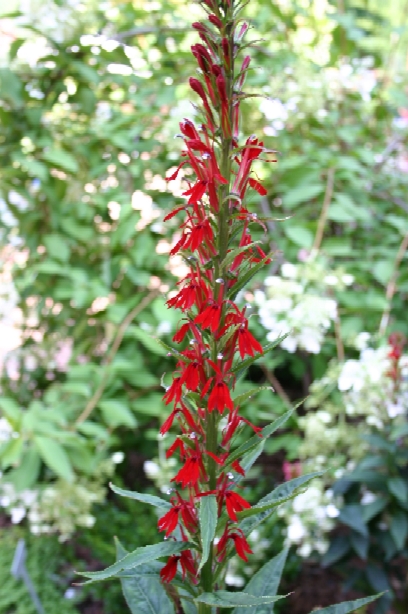Georgia Gardener Newsletter Cool Plant: August 7, 2008
| Cardinal Flower |
| Lobelia cardinalis
|

|
Need garden help?
Check out our Services.
|
Species Native Range: Most of the U.S.
Hardiness: USDA Zones 3-9
Mature Size: 6-12 inches tall and wide, flower stalks to 48 inches
Exposure: Light to partial shade
Soil: Wet to moist
Drought Tolerance: Fair
Ease of Culture: Fair
Cardinal flower is a spectacular native perennial that flowers in the late summer with tall stalks of bright red flowers. A
favorite of hummingbirds, especially those beginning their southern migration, this plant is a must for natural or
native plant gardens. After flowering, the plant produces tiny seeds which should be allowed to drop or collected for
immediate planting in adjacent areas. The parent plants tend to live only a few years but seedlings are easily produced
and germinate quickly. The plants usually have a rosette of basal leaves that remain evergreen through the winter which should
not be covered by mulch.
Grow cardinal flower in rich soil that stays wet to moist in light to partial shade. These plants can tolerate full sun
if the soil does not dry out. Because they bloom so late in the summer, it's best to familiarize yourself with the leaves
in order to avoid accidentally damaging the plants.
Use cardinal flower in rain gardens, near ponds, at the edges of bogs or in natural riparian areas. I've seen outstanding
plantings of cardinal flower in low ditches along road sides. Whether these were natural or intentional plantings,
it was hard to tell. Good companion plants include Joe-pye weed (sun), ironweed (sun), obedient plant (sun, part-shade),
turtlehead (part-shade), ferns (part-shade), etc.
Sources
I have seen cardinal flower on occasion at some local retail nurseries. It is often found at nurseries that carry a
wider selection of native plants.
Randy's Perennials: Lawrenceville
Nearly Native Nursery: Fayetteville
New England Wildflower Society (seed): mail order
Niche Gardens: mail order
Native Plant Nurseries from Georgia Native Plant Society
Copyright © 2008 by Theresa Schrum - All rights reserved
No part of this website may be reproduced without the expressed written permission of Theresa Schrum

